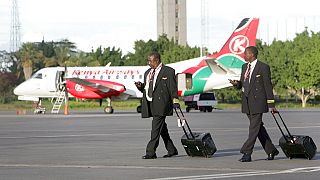Kenya
Africa's magnificent birds of prey can be found soaring above the continent's varied habitats and terrains.
From the large and majestic Martial Eagle, to the colorful Bateleur and the long-legged Secretarybird, scientists are raising the alarm, saying they're quickly disappearing from African skies.
"Basically we are losing some of our most iconic raptors," says Darcy Ogada, a conservation biologist and Africa program director at The Peregrine Fund.
Prior studies have highlighted the severe consequences of rapid human and agricultural expansion on vultures, attributing their decline to habitat alterations and poisoning.
However, a recent study conducted by researchers at The Peregrine Fund and the University of St Andrews revealed similarly alarming declines in other sizable raptors, not reliant on scavenging and less susceptible to poisoning.
Large raptors had experienced significantly steeper declines than smaller species, and this disparity was more pronounced on unprotected land.
The study, published earlier this year in the journal Nature Ecology & Evolution, noted that these diminishing large birds of prey face a dual challenge: their heightened dependence on protected zones coupled with increasingly restricted habitats.
Also, despite expectations that protected areas would ensure the safety of these birds, the study found otherwise.
"Not only are birds of prey declining outside of protected areas, which is a bit expected, but we also found really quite a large - particularly the large birds of prey, like eagles and vultures - have declined inside of protected areas as well. So when you look at what is happening across Africa we are seeing that some of our protected areas are not actually protecting our species. Either they are not big enough or they are mismanaged to a way that the prey populations that are needed to support these raptors no longer exist," Ogada says.
Africa boasts over 100 species of raptors, all of which are experiencing decline.
The study measured changes in population abundance for 42 raptor species Kenya, Botswana, Burkina Faso, Northern Cameroon and Niger in which it study focused on the period between 1969 and 2020, revealing alarming declines in species such as Wahlberg's Eagle, African Hawk-eagle, Long-crested Eagle, African Harrier-hawk, and Brown Snake-eagle.
The research points to two significant challenges faced by these birds: increased dependency on protected areas and reduced restricted habitats.
The study found that African raptors active during the day are particularly vulnerable, with over two-thirds of the studied species qualifying as globally threatened.
The human impact on raptors is evident through poisoning, collisions with energy infrastructure, bird killings due to traditional beliefs, shooting, and trapping.
Retaliatory poisonings by pastoralist communities, aimed at predators such as lions and hyenas, have inadvertently led to the decline of scavenging birds like vultures and eagles.
Ogada highlights the critical role scavenging birds play as the "clean-up crew," preventing the spread of diseases by swiftly consuming carcasses.
"When you think of species like vultures, these are species that have huge implications for what we call 'ecosystem services,' so benefits to mankind, because they are consuming carcasses quickly, therefore limiting the possibilities that these carcasses could spread diseases in the environment,” she says.
The Soysambu Raptor Centre, under the care of renowned conservationist Simon Thomsett, provides a refuge for birds injured by energy infrastructure or community assaults.
Thomsett emphasizes the challenges faced by large birds of prey like the crowned eagle, citing reduced habitats and slow reproduction rates as contributing factors to their vulnerability.
"Things like this take about five to seven years to get sexually mature and only have one egg every two years meaning that if you persecute them they simply cannot bounce back so that is why birds of prey are much more vulnerable than the larger carnivores in many ways,” he says.
Highlighting the critical issue of electrocution as a significant threat, Stephen Githenya, a veterinary technician, underscores the importance of meticulous planning in the placement of power lines to mitigate risks to birds of prey.
Githenya says birds of prey inherently favor elevated perching spots, such as pylons and distribution power lines, as vantage points to spot prey with ease.
Tragically, this preference exposes them to the peril of electrocution when settling or standing on these structures.
"Birds of prey prefer high points that would facilitate them to spot their prey items very easily and this high point include pylons and distribution power lines so when they settle or they stand on those pylons and distribution power lines, they are exposed to electrocution," explains Githenya.
In addition to strategic planning, Githenya stresses the need to insulate power lines to prevent the electrocution of endangered raptor species.
The authors of the study advocate for an urgent expansion of Africa's protected areas, in harmony with the objectives laid out in the Convention on Biological Diversity (COP 15) of 2022.
The convention sets a crucial goal of conserving a minimum of 30% of the world's surface by 2030, a target deemed vital for the preservation of global biodiversity.
Presently, Africa's protected areas encompass a mere 14% of the continent's land and inland waters.











01:40
Conservationists plan mass extermination of destructive mice on Marion Island
02:30
Kenya: After a successful relocation, 21 black rhinos start journey to a new home
02:45
A rhinoceros is pregnant from embryo transfer in a success that may help nearly extinct subspecies
01:35
21 black rhinos relocated to Kenya's Loisaba Conservancy
00:30
Rare pygmy hippo born in Czech zoo makes first appearance
02:10
Rwanda's mountain gorillas: A conservation success Story